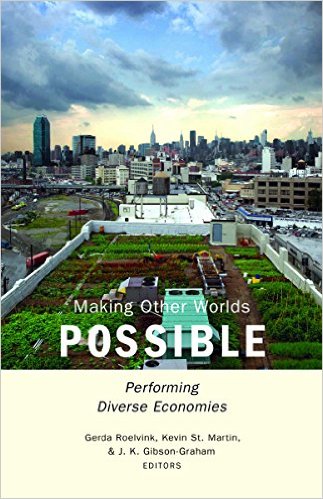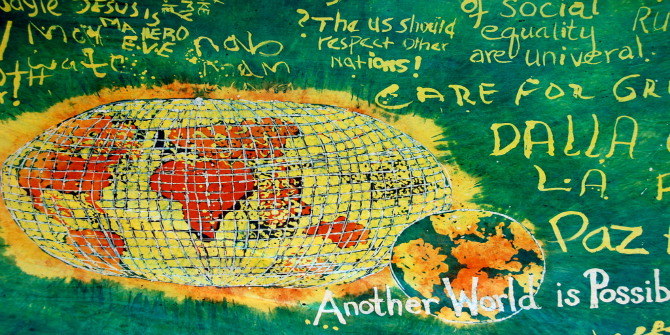‘Capitalism’, writes Mark Fisher, ‘seamlessly occupies the horizons of the thinkable’, to the extent that the apparent lack of alternatives to capitalism barely presents itself as a problem. Bank bail–outs in the wake of the 2007–08 financial crisis only further entrenched the pervasive atmosphere of what Fisher terms ‘capitalist realism’, according to which ‘there is no alternative’: not only no viable alternative, but also no imaginable alternative. Yet, Fisher suggests, in such a situation ‘even glimmers of alternative political and economic possibilities can have a disproportionately great effect’.
In The End of Capitalism (As We Knew It): A Feminist Critique of Political Economy (2006), J. K. Gibson-Graham (the pen name of economic geographers Katherine Gibson and the late Julie Graham) took an altogether different tack. Even to write critically about capitalism or capitalist realism as a pervasive atmosphere is, for Gibson–Graham, to commit the sin of ‘capitalocentrism’. Likewise, to talk of alternatives to capitalism is to represent ‘the economy’ as essentially capitalist, rendering invisible the diverse, non–capitalist economies that exist in the shadow of nonetheless real and exploitative capitalist relations. In Making Other Worlds Possible, members of the Community Economies Collective engage with Gibson–Graham’s ‘diverse economies’ research programme, which, as Gibson, Amanda Cahill and Deirdre McKay write in their contribution, derives its ‘provisional ontology’ from the ‘catchphrase of the World Social Forum: Another World is Possible’ (195).
Image Credit: Batik banner at the US Social Forum in Atlanta, GA (Brooke Anderson)
If the first step in the diverse economies research programme is to posit the economy as ‘irreducible to capitalism alone’, the second, suggests Maliha Safri in her chapter on mapping community economies in Brazil and New England, is to make existing economic diversity visible (305). As Safri states of Redeem-Her, an organisation run by ex–prisoners, representing an institution oriented towards ‘social justice’ as part of an economy can provoke a ‘moment of subjective transformation’ (314) for those who previously felt that it was only banks, businesses and large non–profits that constituted the economy. Here we move towards the third component of the diverse economies approach: an experimental orientation that would see researchers participating in efforts to perform what Gibson–Graham elsewhere describes as ‘community economies’.
Community economies are not to be understood as economies embedded in or serving any putative ‘community’. Instead, community economies emerge wherever ‘ethical negotiations’ take place around necessity, surplus, consumption and the commons (see chapters by Elizabeth Barron, Yahya Madra and Ceren Özselçuk and by Safri). The diverse economies research programme begins by positing ‘the economy’ as irreducible to capitalism; moves to render that existing diversity visible; and enrols researchers in experimental efforts to perform or amplify negotiations around the ethical coordinates of community economies. Though not every contribution realises this methodological ideal in its entirety, Robert Snyder and Kevin St. Martin’s chapter on community-supported fisheries in Maine gives the fullest account of a successful, experimental research project that aided the cultivation (or ‘performation’) of new community economies.
In the anthropological and sociological literature on economic performativity – that is, the extent to which economics helps to bring into being the worlds it purports to merely describe – the role that bioeconomics and fisheries science play in constructing rationalised, commercial fisheries organised around ‘catch shares’ has become a favoured topic. Snyder and St. Martin instead carry out their action research with a group of Maine fishermen frustrated with the environmental degradation and economic decline that accompany the increasingly corporatised commercial fisheries in the region. Starting with a GIS mapping exercise designed to visualise “‘communities-at-sea’’ where there had only been individual ‘‘fishermen’” (34), the fishermen moved to reconfigure the relationship between ‘fish, fishers, and markets’ (38), creating a new community-supported fishery model in which shares were purchased by local residents, who had to be educated in how to process whole fresh fish. Subsequently, the Maine fishermen, with Snyder and St. Martin, conducted research into the possibility of lowering bycatch (unintentionally caught marine species) by deploying differently designed nets, before conducting another mapping project designed to ‘prove’ to the public that they did not fish in sensitive habitats.
Whereas bioeconomics and fisheries science might frame the well-being of community and environment as ‘externalities’ with respect to the fishing economy, these factors here become ‘guiding coordinates for that economy’ (43). Snyder and St. Martin’s role, as they understand it, is not to declare the Maine fishery a community economy, but ‘to document and thereby amplify [the fishermen’s] commitment to an economy that foregrounds community and environment’ (47). Indeed, to ‘focus only on what has become hegemonic would […] only produce knowledge about what is hegemonic, thereby leaving us with greatly impoverished economic imaginations’ (48).
The injunction to move away from critiquing hegemonic economic structures and enrich our economic imaginations by amplifying existing diverse economies is also in Sarah Moore and Paul Robbins’ chapter on political ecology. Moore and Robbins suggest that many political ecologists find themselves stuck when taking ‘the capitalist economy’ to be the ‘one true political target’ (167). Political ecologists seek out alternative relations with socionatures, nonhumans or more-than-humans, but only after differentiating these relations from ‘those enrolled in capitalism’, drawing attention ‘away from proliferating diversity and back to the essential and most important line of difference: between capital and everything else’ (166). Rather than critique, Moore and Robbins re–affirm the importance of experimental action research. If we want to perform posthuman community economies now, Roelvink similarly asks in her chapter, could not highlighting ‘bio–synergies already taking place’ make them ‘more real and a possibility for further action’ (236)?
Making Other Worlds Possible is an often exciting and hopeful volume. The emphasis on experimental action research that seeks to ‘perform’ diverse economies is a vital component that is too often missing from other ‘postcritical’ studies of contemporary economic arrangements. But, in truth, much is shared between the contributors to this volume and ‘capitalocentric’ writers like Fisher, all of whom seek ways to enact noncapitalist economies now. What is perhaps missing from this collection is a sense of how exactly diverse economies might fare when they run up against capitalism, and how capitalist economies might be rendered diverse.
The closing chapter is by Michel Callon, who is concerned with how a market informed by evolutionary, rather than neoclassical, economics might make it possible to maintain the ‘freedom of choice of socioeconomic agents’ (334) regarding Genetically Modified and non–Genetically Modified food products. While this may be a relatively narrow conception of ‘diverse’ economies, Callon identifies strategies for intervening in capitalist economies, writing that ‘since economics is likely to contribute (increasingly) to the constitution of the economy, a promising strategy for intervening in the economy is to intervene in economics’ (323). The Community Economies Collective might be reluctant to take ‘the capitalist economy’ as their target, but they may have much in common with the critical accounting scholars who seek to reclaim accounting – often presented as the representational technology that enabled the birth of capitalism itself – as a site of ethical deliberation, or as a ‘community economy’.


No comments:
Post a Comment